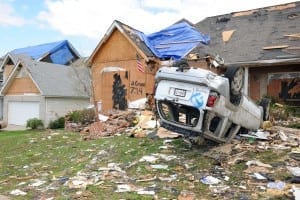The peak months of hurricane activity fall between June and November. Hurricane and Tornado Preparedness, however, is something that should be a year-long concern. Therefore, the activities necessary for Hurricane and Tornado Preparedness should be part of the overall disaster recovery and contingency plan implemented by the facility.
Page Contents
Hurricane and Tornado Preparedness
The most dangerous period of hurricane activity for an area is between late July and September. This means that the activities for Hurricane and Tornado Preparedness should be completed by the close of May (these dates may change according to individual location). Activities that should be completed before the start of the hurricane season include:
- Meeting of the ERT Coordinator, and the ERT Chairmen sometime before the middle of May to review the existing plan, and make changes as necessary
- Memo drawn up soon after the aforementioned meeting, and distributed to all employees summarizing the new plans for contingency operations
- Take inventory and re-supply necessary items prior to June 1 (items may include tape, first aid, candles, etc.)
- Review and update the evacuation routine, and equipment transportation plan, making any necessary changes (also before June 1)
- Review and update the telephone list for all employees, vendors, suppliers and building contractors
- Review these procedures with all employees and ERT Teams, and possibly test procedures during the first week of June
 Hurricane and Tornado Preparedness Checklist
Hurricane and Tornado Preparedness Checklist
In preparing for hurricane season year-round, the amount of work required to be carried out during the actual season itself, becomes less of a burden. This will also suggest a greater sense of security and perhaps eliminate undesirable, panic-stricken situations. During the actual hurricane season itself, the following procedures should be maintained:
If there are no storms in the immediate area:
- Maintain a close watch on the National Weather Service for tropical activity that may affect the Gulf of Mexico and Atlantic Coast
- Continue to review and test the plans, making necessary changes
- Continue to maintain the emergency supplies
If there are tropical storms or hurricanes in the area, but they do not pose an immediate threat (this would include storms outside a 500-mile radius from your location, or landfall 36-48 hours from the area)
- Meeting of the ERT Coordinator and Team Chairmen to discuss the storm track, preparations for landfall, and the time for contingency plan activation
- Maintain a continuous watch on the National Weather Service, as well as on the local networks
- Alert employees to the proposed plan of action
In the event of development that threaten or a possible landfall during a weekend, the ERT Coordinator will be responsible for gathering Team Members for office preparation
- In the event of a severe thunderstorm situation, where there is an eminent strike by a tornado, the ERT Coordinator, or the nearest ERT Team Chairman (Department Manager) should be immediately notified.
- All ERT Team Chairmen should cooperate to immediately assemble all employees into the center of the floor, and away from all windows. The safest areas would be found in the bathrooms, freight elevator rooms, central file rooms, central supply rooms, and any offices located in the interior section of the floor that do not contain windows or glass exposed to the exterior walls and windows.
